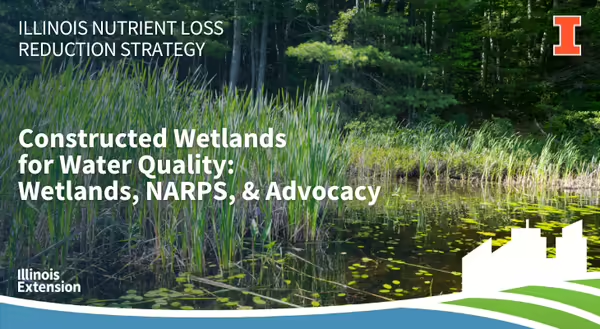
In episode 72 of the Illinois Nutrient Loss Reduction Podcast, Mila Marshall of the Sierra Club’s Illinois Chapter discussed the group’s work to reduce nutrient loss across the state. As a Clean Water Advocate, Marshall supports efforts like Nutrient Assessment and Reduction Plans (NARPs), reviews permits, and promotes wetlands as a practical tool for improving water quality. Marshall shares that she believes the quality of our water is directly connected to the health of our economy, and it is important for farmers and wastewater treatment facilities to find a way forward to support clean water.
What are NARPs?
Nutrient Assessment and Reduction Plans, or NARPs, are developed by major wastewater treatment plants- those that discharge over one million gallons a day into surface waters. These plans are required in watersheds that are impaired or at risk from nutrient pollution and are monitored by the Illinois Environmental Protection Agency (IEPA). The Sierra Club’s Illinois Chapter helps support this work by providing input on plans and encouraging the use of wetlands to meet nutrient reduction goals.
Using wetlands for nutrient reduction
Nutrient loss in Illinois is currently attributed to three sectors: non-point agriculture, point sources (wastewater treatment facilities), and urban stormwater. The Sierra Club’s Illinois Chapter believes that Marshall explained that she sees constructed wetlands as a cost-effective option for wastewater plants while also addressing nutrient loss issues on farmers’ fields. Constructed wetlands are designed to treat water by removing nitrogen and phosphorus before it reaches rivers and streams. She emphasized that proper placement is key. Wetlands need to be located where they’ll be most effective in removing nutrients from the landscape.
Wetlands and the economy
Marshall, who is an ecologist by training, also highlighted how water quality and the economy are linked. Constructed wetlands can reduce costs for wastewater treatment facilities while offering financial benefits for farmers. Landowners may be able to build wetlands on their property and generate income through wetland credits. She shared an example from a Sierra Club event called The River with the Blues, which used blues music and stories to show how Illinois' nutrient loss affects fishing communities along the Gulf. Marshall also highlighted the interest of the Sierra Club’s Clean Water Team in understanding what financial and policy tools are available and what tools are needed to generate money and capital for specific types of interventions, like wetlands.
Advocacy and education
The Sierra Club’s Illinois Chapter works on everything from advocacy to lobbying. Marshall encourages those interested in connecting with local elected officials or wastewater treatment facilities regarding nutrient-related issues to contact her at mila.marshall@sierraclub.org to learn about resources that can help get one familiarized with pieces of legislation or ordinances around water and nutrients in your area.
Marshall focuses on public education, which includes helping people understand how water moves, how nutrients affect communities downstream, and why water literacy matters. In more rural areas, like in central Illinois, she works to educate farmers and local partners about nutrient reduction strategies and to build relationships between agriculture and wastewater treatment facilities. These groups don’t often interact, and she sees an opportunity to bring them together by listening first and promoting wetlands as a shared solution.
To listen to the full interview with Mila Marshall, listen to episode 72 of the Illinois Nutrient Loss Reduction Podcast.
About the authors
Rachel Curry is an Agriculture and Agribusiness Educator specializing in agriculture and watershed education, and she is part of the Illinois Extension's Nutrient Loss Reduction Strategy implementation team. She holds a B.A. in Environmental Studies from Knox College and an M.S. in Environmental Science and Soil Science from Iowa State University, focusing on soil fertility. Her work centers on education and outreach related to the Illinois Nutrient Loss Reduction Strategy, promoting agricultural conservation practices that reduce nutrient loss while enhancing water quality and soil health across Illinois.
Nicole Haverback serves as a Watershed Outreach Associate and is an Illinois Extension team member implementing the Nutrient Loss Reduction Strategy. She holds a B.S. in Agricultural and Rural Policy Studies from Iowa State University. In her role, Nicole coordinates watershed management and planning efforts aimed at reducing nutrient losses in priority areas, offers expertise on best management practices to minimize nutrient loss, and leads outreach initiatives promoting agricultural conservation practices outlined in the Illinois Nutrient Loss Reduction Strategy.
About the blog
At Illinois Extension, we’re working to improve water quality at home and downstream. Every month, our Watershed Outreach Associates will bring you stories highlighting agricultural conservation practices, current research projects and results, and from the field farmer interviews. The Nutrient Loss Reduction blog covers conservation practices recommended by the Illinois Nutrient Loss Reduction Strategy, timely updates, farm safety, and new decision tools to help farmers and producers reduce the nutrients leaving their field.